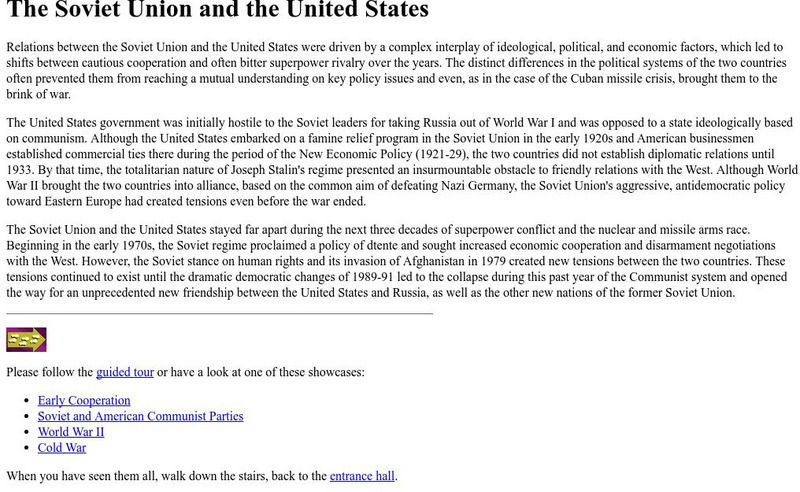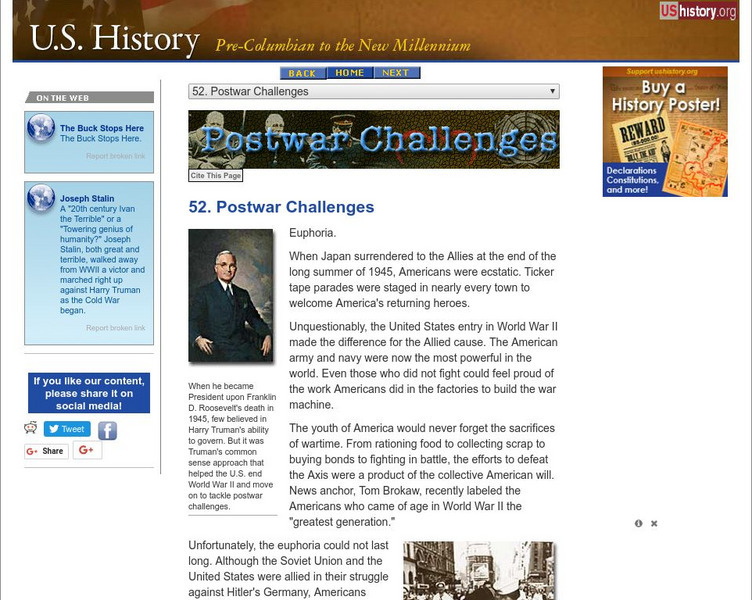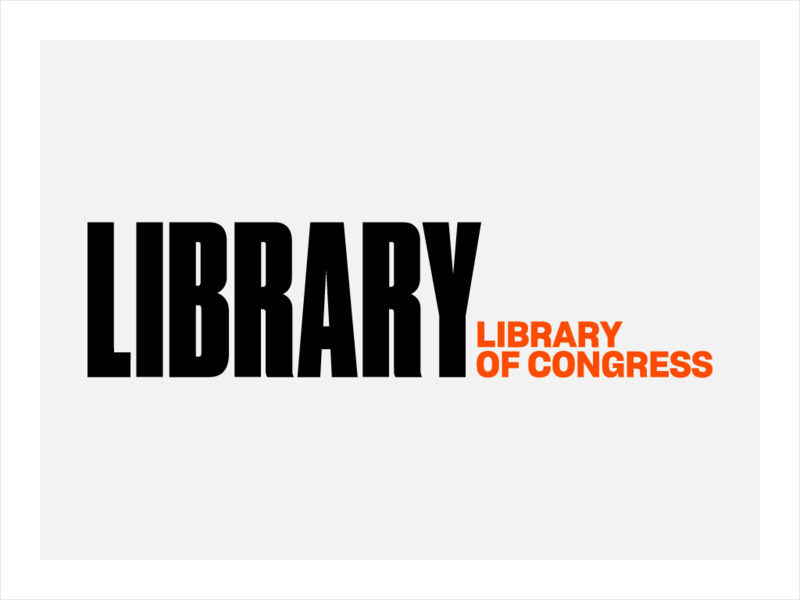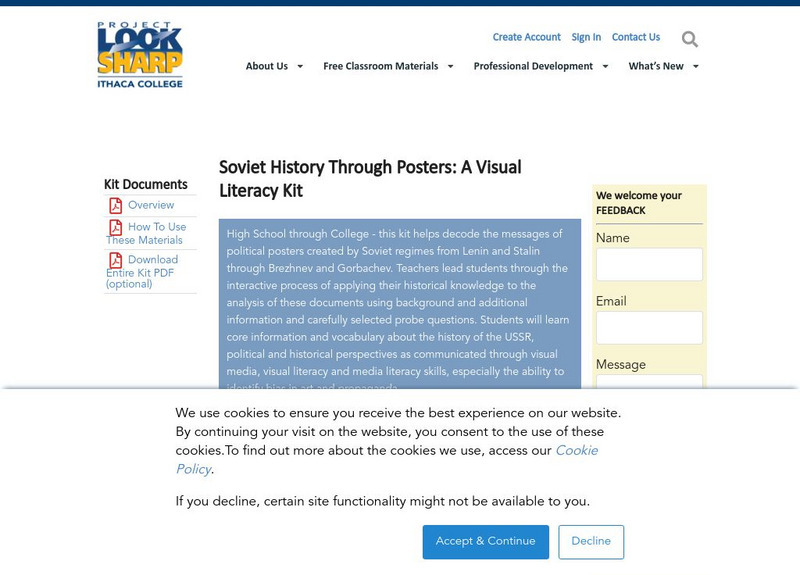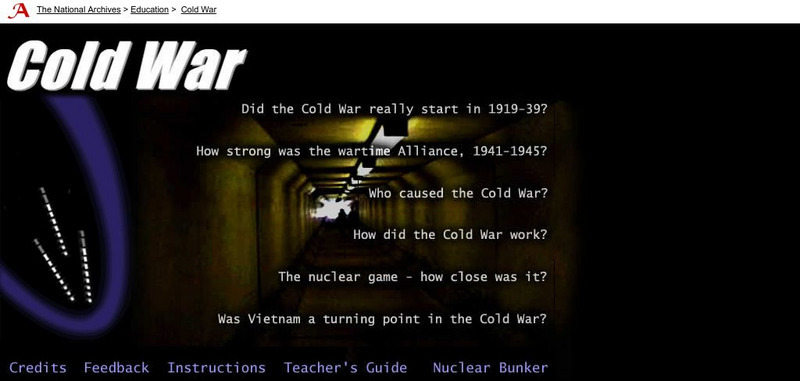Hi, what do you want to do?
Mount Holyoke College
Mount Holyoke College: Early Cold War Era u.s. Foreign Policy
In his article entitled "Economic Interests, Party, and Ideology in Early Cold War Era U.S. Foreign Policy", Benjamin O. Fordham discusses the United States' foreign policy during the Cold War, focusing on the country's ideology, party...
PBS
Pbs: American Experience: The Berlin Airlift
A comprehensive overview of the Berlin Airlift provides links to maps, timelines, and other resources. The entire film is not available at this time, however, a short clip can be viewed. Coverage of the Chocolate Pilot and the support by...
ibiblio
Ibiblio: The Soviet Union and the United States
This site from ibiblio.org gives information about the historical relationship between the Soviet Union and the United States. After reading the summary on this page, click on the links at the bottom of the page to read about early...
University of Groningen
American History: Outlines: u.s. Urges Alliance for Progress
In the field of foreign affairs, President Kennedy faced a series of challenging situations in Cuba, in Southeast Asia, and in Berlin. In 1961, he initiiated a program called the Alliance for Progress aimed to establish economic...
Georgia Department of Education
Ga Virtual Learning: Ap Us History: The Cold War
AP U.S. History unit on post-World War II and the Cold War. Comprehensive multi-media lessons, activities and assessment.
US Department of State
U.s. Department of State: Decades of Change: 1960 1980
Summary of the rise of cultural and ethnic pluralism that took place in America between 1960 -1980 causing major social change. Included were such movements as civil rights, women, Latino, Native-American, counterculture,...
City University of New York
American Social History Proj.: Decoding u.s. Foreign Policy: Iran Contra Affair
Students explore the Iran-Contra Affair using a timeline and related documents, and practice critical thinking about US foreign policy during the late Cold War years, and about the actions of officials of Ronald Reagan's government. They...
US National Archives
Nara: Teaching With Documents: The United States Enters the Korean Conflict
This is a lesson plan outline which correlates the relationship between NSC-68 and U.S. policy in Korea. A National Archives and Records Administration site (NARA) with additional links to more teaching resources.
Alabama Learning Exchange
Alex: News Flash: The End of the Cold War
This lesson is an inquiry into events that occurred during the Cold War era. It is a technology-based project on one event that occurred during the Cold War(1945-1991). The Cold War describes the tense and hostile relationship between...
Independence Hall Association
U.s. History: Postwar Challenges
A brief survey of the beginning of the Cold War and the challenges that faced the United States in confronting communist totalitarianism.
Library of Congress
Loc: Cold War Cuban Missile Crisis
This site details the placing of intermediate-range nuclear missiles in Cuba by the Soviet Union. The article discusses why Khrushchev did this, and what the U.S. did about this. Also provided is the text to Krushchev's letter to JFK...
US Army Center
U.s. Army Center of Military History: The Centennial: Omar Nelson Bradley
This lengthy biography of General Omar Bradley was written on the centennial of his birth. It traces his life as a military man through World War I, World War II, and Chairman of the Joint Chiefs of Staff. Included is a map that shows...
US National Archives
Docs Teach: President Reagan and the Cold War: Vision and Diplomacy
See how Ronald Reagan's rhetoric evolved from his speech calling the Soviet Union an "evil empire" to his signing of the Intermediate-Range Nuclear Forces Treaty by examining photographs and documents.
Other
Ithaca College: Project Look Sharp: Soviet History Through Posters
[Free Registration/Login Required] Multi-unit curriculum kit on the history of the Soviet Union told in five episodes using Soviet posters as source material. Coverage includes the birth of the Soviet Union, Stalin, the Great Patriotic...
Smithsonian Institution
National Air and Space Museum: Apollo to the Moon
This resource offers an in-depth exploration of the U.S. space program and the role President John F. Kennedy took in setting the agenda for manned space flight to the moon.
A&E Television
History.com: The Mariel Boatlift: How Cold War Politics Drove Thousands of Cubans to Florida in 1980
After Fidel Castro loosened emigration policies, some 125,000 Cubans landed on U.S. shores over a span of five months. The Mariel Boatlift of 1980 was a mass emigration of Cubans to the United States. The exodus was driven by a stagnant...
A&E Television
History.com: The Mariel Boatlift: How Cold War Politics Drove Thousands of Cubans to Florida in 1980
After Fidel Castro loosened emigration policies, some 125,000 Cubans landed on U.S. shores over a span of five months. The Mariel Boatlift of 1980 was a mass emigration of Cubans to the United States. The exodus was driven by a stagnant...
US Department of State
Biographies of the Secretaries of State: John Foster Dulles (1888 1959)
Biography of John Foster Dulles provides details of his life and rise to prominence in the U.S. Government.
A&E Television
History.com: Why the Air Force Almost Blasted the Moon With an H Bomb
Detonating a thermonuclear weapon on the moon? It sounds like the bizarre scheme of a deranged comic-book villain -- not a project initiated inside the U.S. government. But in 1958, as the Cold War space race was heating up, the U.S. Air...
University of Groningen
American History: Outlines: The Politics of War
Overview of the underpinnings of war terms negotiated between Allied leaders of Russia, Britain and the U.S. at Yalta in 1945.
US Army Center
U.s. Army Center of Military History: Chapter Ii: The House Divided
This resource provides information on the period in Korea just before the Korean War, and on the partition of Korea by the United States and the Soviet Union.
PBS
Pbs: Frontline: From Arms Race to Arms Sales
During the Cold War, nations like the U.S. and he U.S.S.R. were in a race to develop arms to defend themselves, but what happens to those nations when they collapse and have a stockpile of arms? This activity examines the surplus of arms...
US Department of State
U.s. Dept. Of State: Archive: Inf Treaty of 1987
Copy of the INF Treaty made by the US and the USSR in December of 1987.
National Archives (UK)
National Archives Learning Curve: Cold War
Discusses different aspects of the Cold War such as "Did the Cold War really start in 1919-1939?" and "Was the Vietnam War a turning point in the Cold War?"







